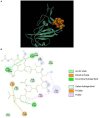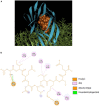A Multifunctional Peptide From Bacillus Fermented Soybean for Effective Inhibition of SARS-CoV-2 S1 Receptor Binding Domain and Modulation of Toll Like Receptor 4: A Molecular Docking Study
- PMID: 33869283
- PMCID: PMC8044374
- DOI: 10.3389/fmolb.2021.636647
A Multifunctional Peptide From Bacillus Fermented Soybean for Effective Inhibition of SARS-CoV-2 S1 Receptor Binding Domain and Modulation of Toll Like Receptor 4: A Molecular Docking Study
Abstract
Fermented soybean products are traditionally consumed and popular in many Asian countries and the northeastern part of India. To search for potential agents for the interruption of the Severe Acute Respiratory Syndrome Coronavirus 2 (SARS-CoV-2) Spike glycoprotein 1 (S1) and human angiotensin-converting enzyme 2 (ACE2) receptor interactions, the in silico antiviral prospective of peptides identified from the proteome of kinema was investigated. Soybean was fermented using Bacillus licheniformis KN1G, Bacillus amyloliquefaciens KN2G and two different strains of Bacillus subtilis (KN2B and KN2M). The peptides were screened in silico for possible antiviral activity using two different web servers (AVPpred and meta-iAVP), and binding interactions of selected 44 peptides were further explored against the receptor-binding domain (RBD) of the S1 protein (PDB ID: 6M0J) by molecular docking using ZDOCK. The results showed that a peptide ALPEEVIQHTFNLKSQ (P13) belonging to B. licheniformis KN1G fermented kinema was able to make contacts with the binding motif of RBD by blocking specific residues designated as critical (GLN493, ASN501) in the binding of human angiotensin-converting enzyme 2 (ACE2) cell receptor. The selected peptide was also observed to have a significant affinity towards human toll like receptor 4 (TLR4)/Myeloid Differentiation factor 2 (MD2) (PDB ID: 3FXI) complex known for its essential role in cytokine storm. The energy properties of the docked complexes were analyzed through the Generalized Born model and Solvent Accessibility method (MM/GBSA) using HawkDock server. The results showed peptidyl amino acids GLU5, GLN8, PHE11, and LEU13 contributed most to P13-RBD binding. Similarly, ARG90, PHE121, LEU61, PHE126, and ILE94 were appeared to be significant in P13-TLR4/MD2 complex. The findings of the study suggest that the peptides from fermented soy prepared using B. licheniformis KN1G have better potential to be used as antiviral agents. The specific peptide ALPEEVIQHTFNLKSQ could be synthesized and used in combination with experimental studies to validate its effect on SARS-CoV-2-hACE2 interaction and modulation of TLR4 activity. Subsequently, the protein hydrolysate comprising these peptides could be used as prophylaxis against viral diseases, including COVID-19.
Keywords: Bacillus spp.; SARS-CoV-2; TLR4/MD2 complex; antiviral peptides; fermented soybean; immunomodulation.
Copyright © 2021 Padhi, Sanjukta, Chourasia, Labala, Singh and Rai.
Conflict of interest statement
The authors declare that the research was conducted in the absence of any commercial or financial relationships that could be construed as a potential conflict of interest.
Figures






References
-
- Albericio F., Kruger H. G. (2012). Therapeutic peptides. Fut. Med. Chem. 4 1527–1531. - PubMed
-
- Arthur D. E., Uzairu A. (2019). Molecular docking studies on the interaction of NCI anticancer analogues with human phosphatidylinositol 4,5-bisphosphate 3-kinase catalytic subunit. J. King. Saud. Univ. Sci. 31 1151–1166. 10.1016/j.jksus.2019.01.011 - DOI
LinkOut - more resources
Full Text Sources
Other Literature Sources
Miscellaneous

